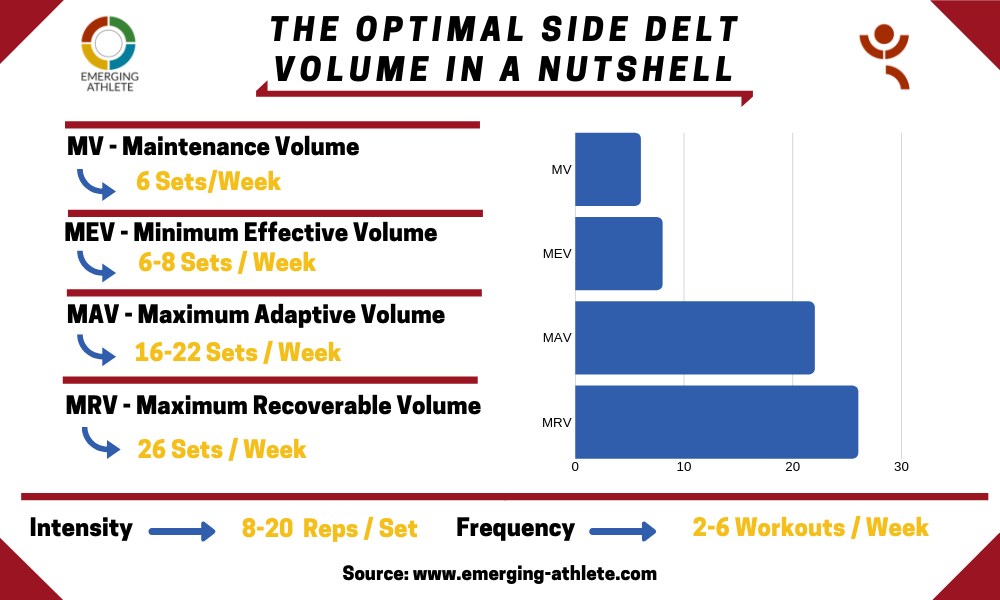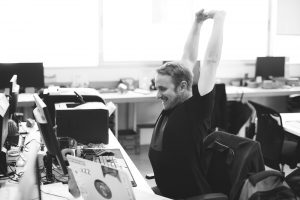Today, in the second part of the shoulder series, we’re going to cover the side delts. Presumably, the major component for the famous “3D shoulder look”.
If you’re not yet familiar with volume, what that actually is, how it affects muscle growth and what you should know about it, check out my free complete guide about the optimal volume for hypertrophy.
Alright, so what can you expect from this volume article series?
Based on Dr. Mike Israetel’s knowledge and experience, as well as our own, we will clarify which volume works best for each muscle and provide landmarks that you can use for further assessment.
Especially for bodybuilders who compete on stage, good side and rear delts are crucial!

Compared to the front and rear delts, side delts definitely need to be handled differently.
Why is that?
First and foremost, front and rear delts are involved in almost every push/pull exercise.
Combined with the fact that these are small muscles, it is quite obvious that you don’t need tons of additional volume to grow them.
Most of the growth originates from your actual training program through compound exercises like bench press, incline press, overhead press or pulling movements like pull-ups and row variations.
However, side delts work differently.
The main function is a lateral arm raise, which cannot be found in any of the basic compound exercises.
According to that, side delts need more attention than the remaining shoulder components.
Thus, this article will clarify all the essential aspects regarding the optimal side delts volume.
MV – Maintenance Volume
Why is it important to know your MV?
Quite obvious.
This is important to know because if you have to fall back from exercising for a certain period, you don’t want to lose your hard acquired gains, do you?
Also, after a period of very heavy and exhausting workouts in between your MAV and MRV or even above your MRV, it is for sure a good thing to lower your volume every now and then.
This helps to desensitize your body again and refill regenerative capacity.
For that reason, it is crucial to know where your MV lies to ensure muscle maintenance while still not accumulating too much volume in your “deload phase”.
So, how much work needs to be done to at least maintain your current side delt’s size?
MV: 6 sets/week
The main side delt movement is to bring your arm up along your body which is why they don’t get involved a lot during conventional pull or push exercises.
One exception that seems to stimulate side delts to some extent is Overhead Press.
Consequently, if you want to maintain your side delts current size, you have to put some additional work in.
Whether you decide on doing either more compound, isolation movements or even a combination of both types of exercises, is totally up to you.
Most folks gain good progress with an average of around 6 sets/week.
But, for all these values applies the same thing.
Everybody is unique. It is impossible to generalize volume merits that work equally for each and every one.
Use these references as a starting point and guide your way to find your personal landmarks.
MEV – Minimum Effective Volume
Before we get closer and more in-depth to the other benchmarks, I want to emphasize the practical application of these values once more.
Remember that for all these values, there is and can be a huge deviation and individual difference is key.
What do I want to say with that?
Only experimentation and tracking your own progress can help you find out what your optimal side delt volume is.
Over time you need to make adjustments on the basis of your current training program.
Why is it important to know your MEV?
That’s simple.
As well as it’s important to have knowledge of how much volume is needed to maintain your side delts current size, it’s at least of similar importance to know how much volume your side delts need to grow.
What is the minimum amount of volume required for growing your side delts?
MEV: 6-8 sets/week
For side delts, the MEV lies between 6-8 sets/week to stimulate some growth.
You can try to train them less, but the thing about side delts is, they’re super easy to exercise and don’t fatigue very fast.
Hence, side delts are pretty fatigue resistant which means you need quite some work to get them growing.
MAV – Maximum Adaptive Volume
Why is it important to know your MAV?
Do you want to train all the time within the least effective volume?
Exactly, who would want that? Nobody.
We all seek for the best results.
In order to get the best possible gains, we need to put more effort into our workout and increase the volume consistently over the weeks of our mesocycle.
Accordingly, it is important to know where your MAV lies to maximize muscle hypertrophy.
What’s the MAV for the optimal side delts volume?
MAV: 16-22 sets/week
The average here fluctuates between 16-22 sets/week.
For example, if your program is split up into push/pull/legs it could look like the following:
After your chest routine, follow up with a heavy compound shoulder press accompanied by some lateral raises.
If you repeat both exercises for 3 sets, that results in a total of 6 sets per workout. If your frequency allows you to complete 3 workouts/week this would be a volume of 18 sets/week for your side delts!

MRV – Maximum Recoverable Volume
Sooner or later in your mesocycle program, you’ll get to a point where your performance starts to stagnate or even decrease.
This oftentimes is an indication for overreaching your MRV. If you want to know more about overreaching, check out the following linked article that I wrote.
What does that mean?
The MRV refers to the maximum volume from your body can recover properly.
In other words, the maximum amount of work that you can sustain without suffering a loss in strength and performance.
Why is it important to know your MRV?
Pretty obviously. Nobody wants to take a forced break by virtue of too much-accumulated volume, right?
Therefore, it is very essential to know where your MRV lies to keep your body recovered and avoid superfluous breaks.
So, what is a good volume that is still recoverable?
MRV: 26 sets/week
Why such a high volume for small muscles like side delts?
As mentioned earlier, these are muscles of the shoulder that aren’t in a position where they take a lot of damage by regular training.
They’re basically not stretch under load to an excessive amount. The weights you use with side delts aren’t super heavy. This is largely due to its construction.
If you compare heavy compound exercises like squats with side delt movements, it gets obvious why you can’t use similar loads. These compound exercises involve a lot of different muscles and really fatigue your body. This means that you also need quite some time to recover from that.
But if we look at the side delts, we mainly train them with side lateral raises.
Movements like that don’t involve as many muscles as squats and also can recover faster.
This means you can also raise the volume for side delts because a) they don’t get involved that much through your usual training program and b) they recover faster from the taken damage.
Frequency
How often can and should you train for the optimal side delt volume?
2-6 workouts/week
Regarding training frequency, side delts behave similarly to biceps. They recover really fast and almost never get exposed to a lot of damage.
That means you can at least train them twice a week. A lot of people benefit from 3-4 times/week. Some folks can even handle 5-6 times/week.
If you have issues growing your delts and your program is build up with a separate shoulder day, you should give it a thought and split it into separate delt workouts because a) they recover really fast and b) according to that you can hit them more often.
Furthermore, if you train them separately it is likely that you will sophisticate increased growth.
For example, if your current shoulder program looks like; 10 sets rear delts, 10 sets side delts and 6 sets front delts, it is probably a better idea to split all that volume up into separate shoulder days.
This can benefit your performance since your shoulders don’t accumulate that much fatigue throughout the week. So, therefore one can expect enhanced performance during the separate shoulder workout and accordingly better progress.
Intensity
How heavy do you need to train for the optimal side delt volume?
8-20 reps
Any less than 8 reps/set or a weight that is too heavy for you to perform 8 reps is endangering the shoulder joint.
Especially lateral raises with heavy weight can cause serious injuries if not done with proper technique.
Anything over 20 reps/set supposable ends in your side delts solely gets fatigued and eventually not grow as you would like them to.
But between 8-20 reps/set you can try out different rep ranges and figure out which works best for you. High reps work pretty well for the delts because they’re relatively slow-twitched muscles.
If you think about it makes sense. Your side delts are almost always on and in use. Therefore, it is only logical that some of you might not feel 8 reps/set as good as higher reps around 15 reps/set.
According to that, you can vary the rep ranges and combine both, a heavier focus with around 8 reps/sets and after some time you can switch to lighter weight with 12-15 reps/set.
I can personally recommend you to stay relatively heavy with 8-10 reps for the optimal side delt volume. It really boosted my side delts to the next level since I implemented heavy side delt lateral raises.

Side delt workout – Exercises
Are there any important things to consider for the side delt workout?
Oh yes, sure thing. The same as with rear delts, which will be covered in the next article.
You should really make sure to have a good mind muscle connection when training small muscles like the front, side or rear delts.
Because if you use a lot of momentum and swing, oftentimes other muscles take over the work of the targeted muscle.
In the end, you waste potential to grow them properly.
Therefore, make sure you execute them with excellent technique, no swinging and only use weights that you can control!
Side delt Exercises:
- Upright Rows (Dumbbell/Barbell)
- Lateral Raises
- Dumbbell/Barbell Shoulder Press
- Lateral Cable Raises
All of these exercises have many types of variations, so feel free to try them out and figure out which one suits you the best.
Range of motion
I cannot emphasize it too often, range of motion is a big deal for every muscle. It is proven that a proper execution with a full range of motion does activate a lot more muscle fibers than some kind of cheat swing that even increases your risk of injury.
Sure heavyweights might encourage your ego, but where’s the point in wasting potential muscle growth and even risking your health?
If you take something through a full range of motion safely it almost always gives you the most growth. This is because stretch under load is a big hypertrophy factor.
Furthermore, when you’re doing a full range of motion you activate as many muscle fibers as possible which likewise result in increased muscle growth.
Conclusion
In summary of the optimal side delt volume, we can record the following landmarks.

Exercises: Some of the most common and effective side delt exercises are Upright Rows (Dumbbell or Barbell), Lateral Raises (Dumbbell or Cable) and Shoulder Press (Dumbbell or Barbell).
Range of motion: Don’t ever sacrifice range of motion for heavier weights that you cannot control properly. This results in a higher risk of injury and reduces the actual muscle growth potential.
Practical Tips
Back again at our practical section, here I gathered some techniques that work quite well for side delt training and can be implemented from time to time.
Supersets: heavier compound exercise + isolation exercise or vice versa.
If you want to dig deeper, check out the following link to read a whole article about supersets.
For side delts, this can be: lateral side raises almost until failure followed by a pre-loaded upright row variation until failure.
This is a good technique to save time during your workout and get a great pump.
Means, any isolation exercise combined with a compound movement. You first start off with a compound movement and directly afterward you use a preloaded/set up isolation exercise.
Drop sets: You choose a certain weight and go until failure, then you reduce the weight and again go until failure. Reduce another time and so on until you’re not capable to do any more reps.
For further information, I wrote a full article about drop sets, just click the previous link.
Giant sets: You set yourself a certain number of total reps, then do as many sets as you need to reach this certain number of reps.
For example, take 60 lateral side raises.
In the first set, you do 15 reps, second 12 reps, third 10 reps and so on. Continue this way until you reach your set number (in this case 60 reps in total).
Special shout-out to Dr. Mike Israetel, we really value his knowledge and the content that he shares with you guys on his YT channel and his blog.
Definitely check out his video about side delt volume!
Did you learn something new about side delts today?
Leave a comment below and share your experiences with us!
If this article helped you, we would appreciate if you can share this with your friends and family. Make sure to subscribe to stay up to date and not missing out on upcoming content.
For any further questions, don’t hesitate to leave a comment below or connect with us through our social media channels.
Cheers for reading, guys
Claas





2 thoughts on “The Optimal Side Delt Volume – Hypertrophy Guide”
Hi there! Such a wonderful short article, thanks!
thank you!